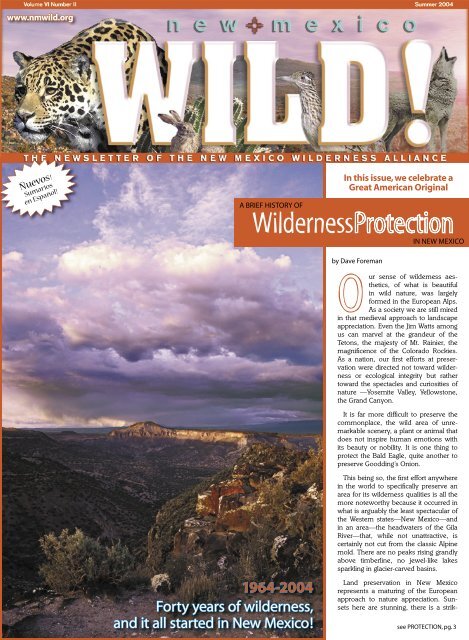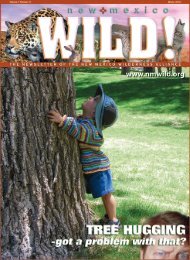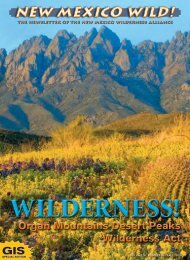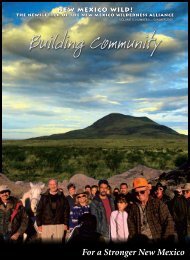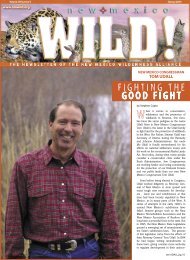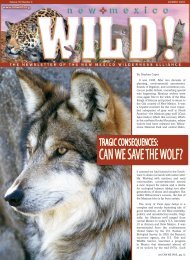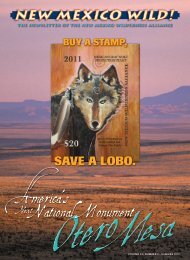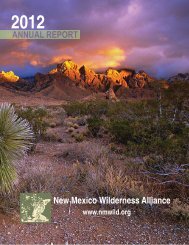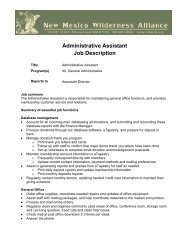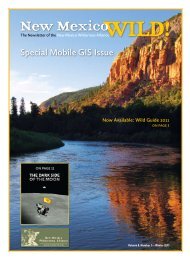WildernessProtection - New Mexico Wilderness Alliance
WildernessProtection - New Mexico Wilderness Alliance
WildernessProtection - New Mexico Wilderness Alliance
- No tags were found...
Create successful ePaper yourself
Turn your PDF publications into a flip-book with our unique Google optimized e-Paper software.
129 UMB 5831 004000 50 Farfalla F CECCONI MATILDE 1998 UMB00005 CNAT amici del Nuoto Città di Castello (PG)130 UMB 5831 004400 50 Dorso F CECCONI MATILDE 1998 UMB00005 CNAT amici del Nuoto Città di Castello (PG)131 UMB 6288 013500 100 Stile Libero F DE ANGELIS VERONICA 1999 UMB00005 CNAT amici del Nuoto Città di Castello (PG)132 UMB 6288 004400 50 Stile Libero F DE ANGELIS VERONICA 1999 UMB00005 CNAT amici del Nuoto Città di Castello (PG)133 UMB 4944 011600 100 Stile Libero M GALLORI MARCO 1997 UMB00005 CNAT amici del Nuoto Città di Castello (PG)134 UMB 4944 003400 50 Stile Libero M GALLORI MARCO 1997 UMB00005 CNAT amici del Nuoto Città di Castello (PG)135 UMB 4944 014000 100 Rana M GALLORI MARCO 1997 UMB00005 CNAT amici del Nuoto Città di Castello (PG)136 UMB 4944 004500 50 Rana M GALLORI MARCO 1997 UMB00005 CNAT amici del Nuoto Città di Castello (PG)Create PDF files without this message by purchasing novaPDF printer (http://www.novapdf.com)
Preserving the Desert JaguarOscar Moctezuma O.General Director Naturalia, A.C.When we hear someone mentionsthe jaguar (Panthera onca), the firstimage we get is one of the big catmoving quietly through the tropicalforest in search of its prey. Althoughthis is a correct vision of the typicalhabitat in which this species lives, itdoesn’t show a complete image ofthe adaptability of the largest wild catof the American Continent, which hasadapted to other natural conditionsthat have very little similarity to thetropical forest.Perhaps we can find the most dramaticexample of this adaptability inthe case of the northernmost populationof this species that lives in Northwest<strong>Mexico</strong> in the arid mountainsof the state of Sonora. Here, surroundedby a strange combinationof plants, including big cacti, fig trees,palms and oaks, among others, jaguarshave lived perfectly adaptedsince they first appeared in this continent.Today, however, this powerfulpredator has disappeared from morethan half of its original range and israpidly declining in the regions inwhich they have survived to this day.Habitat loss, fragmentation and overhunting,have contributed to placethe jaguar among the most endangeredspecies in <strong>Mexico</strong> and in mostof its entire range.Nowhere is this more apparentthan in the United States-<strong>Mexico</strong> borderlandswhere, within one humanlifetime, the unique American jaguarhas been virtually eliminated fromits entire U.S. range. The last residentanimals were hunted in SouthwestU.S. more than sixty years ago.While individual jaguars continue tobe documented in the mountains ofSouthern Arizona and <strong>New</strong> <strong>Mexico</strong>,these are dispersers from the nearestsurviving population in the northernMexican state of Sonora near theconfluence of the Aros and YaquiRivers, just 120 miles south of theinternational boundary.This unique ecological area hostsbetween 70-100 jaguars, as well asnumerous other rare species includingocelots (Leopardus pardalis), militarymacaws (Ara militaris), lilaccrownedparrots (Amazona finschi),bald eagles (Haliaeetus leucocephalus),Neotropical river otters (Lontralongicaudis) and Gila monsters (Helodermasuspectum), among others.Jaguars are, along with mountainlions (Puma concolor), the top predatorsin the area and their natural preyinclude white tailed deer (Odocoileusvirginianus), javalina (Tayassu pecari)and hares (Lepus callotis). Unfortunately,the main productive activity inthe area, the cattle ranching, has suppliedthem with an additional prey:cows.Occasional cattle killings haveincreased the rejection to jaguars andmountain lions and has moved someranchers to kill them in spite of beingan illegal action (jaguars are protectedby law in <strong>Mexico</strong> but there is almostno law enforcement on the ground).Within the last four years, at least27 jaguars, including females and kittens,have been killed by ranchersand poachers – as much as one-thirdof this small but critical population. Itwould be a shame to allow the totalextermination of these magnificentpredators and lose this unique population,the jaguar of the desert.Strategic efforts are underway tostem these losses, to recover jaguarsthroughout asignificant portionof their historicrange andto conserve theunique biologicaldiversity ofthis threatenedborderland ecosystem.Naturalia,A.C., a Mexicanconservationgroup, hasdecided to workfor the preservationandrecovery of thedesert jaguar.To accomplishthis goal, Naturaliahas partneredwith severalAmericanconservation groups, including theNorthern Jaguar Project, Defenders ofWildlife and the Wildlands Project, toaccomplish this by building local supportfor conservation, acquiring strategicranches to protect jaguar habitat,minimizing predator/livestockconflicts and implementing programswhich will change the local community’sperception of the jaguar from aliability to an asset.Our long- term goal is to recoverjaguars throughout a significant portionof their historic range by expandingthis population in <strong>Mexico</strong> andby preserving habitat connectivityfor dispersal and re-colonizationinto appropriate areas in the U.S.Recovering the American jaguar inthe U.S. depends on protecting thelast remaining population in northern<strong>Mexico</strong>.In July 2003, Naturalia purchaseda ranch in the core area used by jaguars,establishing a foothold in thecommunity for conservation. Fromthis area, we’ll continue our work topreserve the biodiversity of the areaand look for productive alternativesfor the local community. This way wehope to find a way to build a tolerantattitude toward jaguars and increasecommunity acceptance for them andsupport for its conservation.To save the desert jaguar is a challengethat offers an opportunity forbi-national collaboration and a hopeto maintain the vital role of this magnificentcreature in the North-Americandesert.españolNos imaginamos aljaguar como un gatogrande moviéndosesilenciosamente dentro deun bosque tropical. Pocagente sabe que el jaguar havagado por las montañasáridas del noroeste de Méxicodesde que primero aparecióen este continente. Hoyen día, la pérdida de su habitaciónnatural y la caceríaexcesiva han resultado enconvertir al jaguar en una delas especies que está en peligrode extinción en México.Dentro de los últimos cuatroaños, al menos 27 jaguareshan sido matados por rancherosy cazadores ilegales.Esta cantidad de jaguareses un tercio de la poblaciónpequeña de los jaguares desérticos.Naturalia, un grupomexicano conservacionista,está trabajando para recuperara la población de losjaguares en un área significantede su terreno naturalhistórico. Naturalia proponerealizar su misión ampliandola población de jaguares enMéxico y preservando suhabitación natural para reintroducira los jaguares enlas áreas apropiadas en losEstados Unidos.<strong>New</strong> <strong>Mexico</strong> WILD!Page 7
Nature Made the Gila RiverBy Dutch SalmonOf <strong>New</strong> <strong>Mexico</strong>’s six mainstemrivers, only the Gilastill fl ows free. Of ournation’s many wilderness areas,only the Gila is our nation’s fi rst. Ofsporting fi sh, only the smallmouthbass earns the accolade “thegamest fi sh that swims.” I standin the free fl ow of the Gila River,fl y rod in hand, in pursuit of thewild bronze bass and the scene isso bucolic, and the concurrence ofqualities so rare, it is hard to imaginethat over the mountains turmoilbrews over this water. Is this whatGod intended for the Gila River?A 1968 Congressional Act (PublicLaw 90-537) authorized as part ofthe Central Arizona Project (CAP),18,000 acre feet (af) of Gila Riverwater for <strong>New</strong> <strong>Mexico</strong>, providedthe project did not cause “economicinjury” to downstream usersin Arizona. To protect these downstreamentities (mostly Gila RiverIndian tribes), Arizona users wereto be compensated by 18,000 acre<strong>New</strong> <strong>Mexico</strong> Wildlife FederationPresident Appears on“Hippest Comedy Show in America”Makes America Laugh forthe Good of Otero MesaIf you don’t have cable or satellitetelevision, you’ve probably neverheard of “The Daily Show With JonStewart.” The Daily Show has beencalled the “hippest show in America”and has become extremelypopular as a comedy program thatfi nds the funny side of real news—delivering laughs to millions ofAmericans every evening.Nobody appears on The DailyShow without being poked fun at,but NMWF President Oscar Simpsondidn’t hesitate when he gotthe call requesting that he appearon the nationally televised comedyshow.Simpson appeared on the programalong with <strong>New</strong> <strong>Mexico</strong>rancher Tweeti Blancett to tellAmerica that hunters care deeplyabout protecting our environmentand wildlife for generationsto come. In particular, Simpsonand Blancett talked about OteroMesa and the federal government’sunfortunate lack of respect for thewildlife and groundwater resourcesfound there. The Daily Show sent areporter and cameraman to <strong>New</strong><strong>Mexico</strong> to cover the story.The television program showsSimpson telling the reporterpoint blank, “President Bushdoesn’t care about Otero Mesa.”The reporter’s response will giveyou an idea of how The Daily Showdiffers from standard news.“Won’t people just say it’s all sopredictable?” the reporter asksSimpson, “Aren’t you just anotherone of those gun-toting, NRA-supporting,pickup-truck driving, anti-Bush people?”Missed the program? Youcan still see the clip online atwww.comedycentral.com/tv_shows/ds/Click on “correspondents,” then“Samantha Bee,” then “Kill Drill” toview the clip.feet from the Colorado River, andonly surplus “fl ood fl ows” from theGila were to be captured in <strong>New</strong><strong>Mexico</strong>. Many readers will recallthe Conner Dam proposal of the1980s, which sought to captureand develop this water while satisfyingthe economic injury clauseand fi scal and environmental concerns.Ultimately, this project wasshelved by the Bureau of Reclamation(BOR) and the 18,000 af,though technically still “authorized,”was never funded. Thatcould change with the currentArizona Water Settlements Act(S. 437) which has reached theU.S. Senate fl oor. Designed tosettle long-standing water issuesbetween Indian tribes and waterusers in <strong>New</strong> <strong>Mexico</strong> and Arizona,the <strong>New</strong> <strong>Mexico</strong> delegationis working hard to seethat funding for the act includesmoney to build the <strong>New</strong> <strong>Mexico</strong>unit of the CAP.Recent meetings in Silver Cityhave sought to establish a JointPowers Commission of local 4-county representatives (Grant,Luna, Hidalgo and Catron Counties)to contract for this water.Grant County Attorney Jack Hiattspoke of a “window of opportunity”provided by S.437 to give<strong>New</strong> <strong>Mexico</strong> its rightful shareof the Gila River. Catron Countyrepresentative Howard Hutchinsonsaid, “There is no doubt –this is not only our best chance(to capture the water), it’s ourlast chance.” All of the municipaland county representativesfor the 4-county Joint PowersCommission were unanimous insupport of <strong>New</strong> <strong>Mexico</strong>’s effortsto capture the 18,000 af via theArizona Water Settlements Act.Many citizens in the audienceweren’t in agreement with theirelected offi cials, however, andit’s too bad the <strong>New</strong> <strong>Mexico</strong> delegation,and Governor Richardson,weren’t in attendance tohear their reasons why the projectshould not proceed. I will tryto sum up their concerns, andmine.First, it is worth noting whythe Conner Dam proposalespañolRepresentantes legislativosde los condados de Grant,Luna, Hidalgo y Catronesperan obtener 18,000pies de acre de agua del RíoGila que fueron autorizadosen el Acta de Congresode 1968 como parte delProyecto Arizona Central.Los anteriores intentos decapturar el agua fueronabandonados, pero esopodría cambiar con el actualActa de Establecimientode Agua de Arizona, la cualestá en consideración porel Senado Estadounidense.Diseñado para resolver losasuntos de agua históricosentre los pueblos indígenas ylos consumidores de agua enNuevo México y Arizona, ladelegación Nuevo Mexicanaestá trabajando duro paraasegurar que los fondos parael Acta incluyen dinero paracapturar el agua del Río Gila.Actualmente, una coaliciónde ciudadanos preocupadoscree que dejar él Rió Gila en suestado natural es en el mejorinterés de la gente. Debemosde reconocer que en fin esnuestra responsabilidad decuidar y proteger el Río Gilapara las generaciones futurasen vez de discutir sobre quiendebe tener el acceso a estaprovisión de agua natural yposiblemente destruir esteregalo precioso.failed. I was a member of the <strong>New</strong><strong>Mexico</strong> Interstate Stream Commissionat the time and I well rememberwhen the BOR pulled the plugon the Conner Dam. The agency,as required by law, did a cost/benefi t analysis, comparing the feasibilityof developing water on theriver via the $100 million ConnerDam vs. the possibility of local governmentpurchase of existing waterrights. They found that there werethousands of acre feet of unusedwater rights lying fallow in both thePage 8 Summer 2004
Volunteer ProfileBob Willisby Stephen CapraMimbres and Gila basins and thatpurchase of such rights would beabout half the cost per acre foot ofdeveloping river water. Where thenwas the rationale for a $100 millionwater project?Nearly 20 years later that rationaleappears even weaker. Accordingto the recently completedSouthwest (NM) Regional Waterplan, Chino Mines (Phelps Dodge)groundwater rights in the MimbresBasin total approximately25,000 af; actual use in 2002 –about 5,000 af. Over the ContinentalDivide in the Gila Basin, TyroneMines (Phelps Dodge) holds nearly11,000 af of water rights (plus 2100af in the Mimbres basin); actual useat their mine and Gila farm – about6,000 af. The total unused allotmentequates to over 25,000 af.This is not to criticize the miningcorporation, which has done a generallygood job of land and waterstewardship in the Gila Valley,but to point out the obvious: asmall portion of what the corporationis not now using would satisfyMunicipal and Industrial use inGrant County for decades to come.Indeed, there are more local waterrights lying fallow than could beprovided by the <strong>New</strong> <strong>Mexico</strong> unitof the CAP.Meanwhile, the cost of newwater development has jumped.In a statement to the Senate Energyand Natural Resources Committeein September, 2003, <strong>New</strong> <strong>Mexico</strong>State Engineer John D’Antonio said:“We believe we can build a suitableproject for approximately $220million —In the settlement, <strong>New</strong><strong>Mexico</strong> has proposed, and Arizonais considering $150 million infunding for the <strong>New</strong> <strong>Mexico</strong> unit …<strong>New</strong> <strong>Mexico</strong> would have to makeprovision for at least $70 million inconstruction costs plus substantialannual costs.”Seventy-plus million dollars is avery substantial sum in the statebudget of <strong>New</strong> <strong>Mexico</strong>. For thelocal (4-county) taxpayers, upfrontenergy costs were considered atthe Joint Powers meeting of $74/af – about $1.3 million per year, ascary sum at the local level. Shouldlocal and state taxpayers be askedto pony up this kind of money fora water project that is clearly notneeded, just to keep Arizona fromgetting that water?Remember: in a region with littlegrowth, costs will have to be paidyearly whether there are buyersfor the water or not. And Demingand Lordsburg, and Catron County,would appear to be too distant geographicallyto make use of GilaRiver water. Finally, constructioncosts alone would leave the 18,000af costing more than $12,000/af.A discussion of possible environmentalconflicts and concernswould take another column. I willnote here that a mainstream damis not being considered, but ratheran off-stream reservoir in MangasCreek with a large pumping stationon the river to capture the occasionalflood events. Mangas Creekis a perennial flow in its own right,a prime riparian area that may holdone or more threatened or endangeredspecies.A more serious concern may bethe “capture” of flood flows by alarge pumping station. It is wellknown that flood events rejuvenateriparian habitats and thereby speciesup and down the food chain.The Gila River persists throughdroughts and counts its floods asrevival events. It is the last majorflow remaining in the state that canteach us what a natural river shouldlook like.Rather than new diversion andconsumption, <strong>New</strong> <strong>Mexico</strong> shouldtake its funding from the ArizonaWater Settlements Act and use itfor watershed and riparian restorations,in-stream flows, and the purchaseof idle water rights for eventualallocation according to needs.Standing in the free flow of theGila River in pursuit of sporting fish,the in-stream values of the Gila areincumbent in the view. A coalitionof anglers, hunters, birdwatchers,hikers, river runnersand fiscal conservatives– believes it best servesthe people left in its natural state.Nature made the Gila River. Itsfuture, however, is in our hands.There are many people who stepin at critical moments to help the<strong>New</strong> <strong>Mexico</strong> <strong>Wilderness</strong> <strong>Alliance</strong>in our efforts to protect wildlandsin our state. However, few peoplehave stepped forward and given asgenerously as filmmaker and headof The Image Exchange, Bob Willis.I met Bob in the early days of ourfight to protect Otero Mesa. With30-second commercials averaging$28,000 it was unlikely we wouldbe getting our message out on theairwaves. Bob Willis stepped upand put together not one- but twocommercialsat no cost to our organization.These commercials had adramatic impact on our ability toget the issue of Otero Mesa to abroader audience. But Bob did notstop there. When our Otero MesaPublic Forum was held at the Kimoin January, it was again Bob whowas there to record the event andlater to edit the event into a compelling8-minute piece that has hada big impact on viewers and fundingresources.Bob is an accomplished filmmakerwhose clients include theState of <strong>New</strong> <strong>Mexico</strong>, the Universityof <strong>New</strong> <strong>Mexico</strong>, the <strong>New</strong><strong>Mexico</strong> Department of Forestry,the City of Gallup, Senior Arts, RioGrande Jewelry and the list goeson. Recently, Bob’s latest film “RioGrande, Live River or Ditch,” airedon KUNM-TV. The Image Exchangewas established in 1986 in Albuquerque.It specializes in producingdocumentary, educational andtraining programs for non-profit,government and corporate clientsin <strong>New</strong> <strong>Mexico</strong>. They offer full servicepre-production, productionand post production.Bob Willis has given a gift to thepreservation of wildlands across<strong>New</strong> <strong>Mexico</strong>. He is a great friendwhose generosity and hard workhave made a real difference!<strong>New</strong> <strong>Mexico</strong> WILD!Page 9
<strong>Wilderness</strong>:A Bi-partisan Affairby Stephen Capra<strong>Wilderness</strong> has alwaysbeen a bi-partisan politicalissue. In <strong>New</strong> <strong>Mexico</strong>,much of the wilderness we enjoytoday is the result of the dedicationof wilderness activists and effortsby Senators Clinton Andersonand Pete Domenici. However, thespirit that came from the passageof the 1964 <strong>Wilderness</strong> Act seemsat times to have faded completelyfrom sight as we prepare to celebratethe 40th anniversary of theAct that to date has protected some105 million acres of land acrossAmerica.With the signing of the <strong>Wilderness</strong>Act, some 9.1 million acres of landbecame wilderness with the strokeof President Johnson’s pen, includingthe nation’s first wilderness-theGila. Johnson would add another800,000 acres of wilderness duringhis tenure, including the first billto move through congress, the145,118 acre San Rafael <strong>Wilderness</strong>near Santa Barbara, California.The Nixon Administration wouldfollow and while the total acreageof designated wilderness wasnot as dramatic-1.6 million acrestherewere tremendous effortsmade to process hundreds of recommendationsof lands for wildernessdesignation. Locally, <strong>Wilderness</strong>bills included the Salt Creek<strong>Wilderness</strong> near Roswell, whichwas established in 1970. It wasalso during the Nixon years thatthen Interior Secretary, Rogers C. B.Morton, worked through the complexAlaska Native Claims SettlementAct. The resolution of whichlaid the groundwork for the historicAlaska Lands Act of 1981. Many ofthe lands identified in the Nixonyears became some of the core wildernessareas in the Carter Bill.Following Nixon’s resignation,Gerald Ford took over the Presidencyfor three years. During thistime 3.1 million acres of wildernesswere designated, including30,287 acres of riverside forestin the Bosque del Apache and23,267 acres of desert canyonsand cliffs in Bandelier NationalMonument. The key to these successesremained strong bi-partisansupport. But it was Jimmy Carterwho would set the standard forwilderness preservation. Duringhis Presidency, Carter focused onAlaska and pushed for passage ofthe Alaska Lands Act. When Congresswas stalling and filibustering,Carter and Interior Secretary, CecilAndrus, created a 100 million acrenational monument of Alaska landsin 1978. This changed the politicaldynamics and Congress movedon legislation. In 1979 the Housepassed a strong bill only to havethe Senate committee approve amuch weaker bill. With the electionof Ronald Reagan, conservationistswere forced to accept the weakerbill, but it still was historic in size.On December 2, 1980 the AlaskaNational Interest Lands ConservationAct was signed into law by theoutgoing President Carter. In all, 55million acres of wilderness wereadded to the system, doubling itssize in a day.During the Reagan Presidency,the whole issue of the environmentbecame more of a political footballwith the elevation of people likeJim Watt to positions of real power.While the majority of Americansonce held strong support for conservationmeasures, public opinionbecame more divided as specialinterests pushed an agenda thatwas hard on the land, but sweet forinvestors. This was also the timewhen conservative talk radio beganto hit the airwaves. In those timeslisteners were few, so controversialsubjects were needed to livenup the conversation. The environmentbecame an easy target. Buteven as trouble was brewing, PresidentReagan signed into law thecreation of some 10.6 million acresof wilderness nationally, includingin <strong>New</strong> <strong>Mexico</strong> the creationof the Bisti-De-Na-Zin, West Malpaisand Cebolla wilderness areas.While Reagan may have foughtmany environmental policies, hewas, with a few exceptions, willingto protect land on a truly nationalscale.The first Bush Presidency wouldfollow Reagan’s. While Georgesenior would promote drilling inthe Arctic National Wildlife Refuge,he would also go on to protectover 4 million acres of wildernessacross the nation, including 90,000acres in the Ruby Mountains ofNevada, 25,370 acres at PointReyes National Seashore in Californiaand 40,000 acres of desert andarid forest at Wabayuma Peak inArizona, to name a few.In the first years of the ClintonAdministration, wilderness billsmoved forward, including the creationof the California Desert Pro-Page 10 Summer 2004
tection Act which protected some3.6 million acres of wilderness insouthern California. But the <strong>New</strong>tGingritch Revolution of 1994,resulting in Republican control ofthe House of Representatives, puta serious chill on the protectionof our public lands. In fact, duringthe following two years of the105th Congress not a single acreof wilderness was created. It wasduring this time that the oil andgas, mining and power companiesmore openly set up shop in WashingtonD.C.By the 106th Congress wildernesswas once again a bi-partisanaffair and the result was thepassage of several important billsincluding: the Dugger Mountainsin Alabama; the Black Rock Desertin Nevada at 757,000 acres; andthe Steens Mountains in easternOregon, which included 100,000acres of cow-free protection. The“cow-free” distinction is signifi cantin that The <strong>Wilderness</strong> Act authorizesgrazing in most wildernessareas.But it was in the fi nal few yearsof the Clinton Administration thatin addition to the 9.5 million acresof wilderness he had already protected,the President did an extraordinarything. Through his use of theAntiquities Act, he would go on toprotect lands as National Monuments.It began with the controversialGrand Staircase-EscalanteNational Monument in Utah, whichat 1,870,800 acres was larger thanany National Park in the state.Before his term ended, PresidentClinton would protect close to 5million acres in 15 new NationalMonuments, including the spectacularKasha-Katuwe Tent Rocks areahere in <strong>New</strong> <strong>Mexico</strong>.Since coming into Offi ce, GeorgeW. Bush has shown little of the bipartisanspirit we have come toknow with wilderness. Substantialresistance to wilderness legislationcomes from the chairman of theHouse Natural Resources Committee,Richard Pombo (R CA). Pombohas historically held close to a zerovoting record when it comes to theenvironment (League of ConservationVoters). But its Pombo’s brazenanti-wilderness stance that perhapshelps to explain the relativelow amount of wilderness createdthus far in the Bush Administration,about 500,000 acres total. InMay, Pombo sent a letter to fellowmembers of the House explaininghis new rules for considerationof areas for wilderness. His criteria,fi lled with dogma designed toexpedite the declassifi cation of <strong>Wilderness</strong>Study Areas, seemed primarilydesigned to halt new wildernesslegislation. Though not legallybinding, as head of the Committee,his personal agenda carries tremendousweight in blocking legislationfrom reaching the fl oor for avote.While all of that may sounddepressing, there is plenty of goodnews to be found in what manyperceive as atough workingenvironment.Currentlyseveralbills are pendingthat couldadd up to onemillion acresof wildernessto the <strong>Wilderness</strong>PreservationSystemin the comingmonths.These includeour ownOjito <strong>Wilderness</strong>Bill thatwould protectapproximately11,000 acresof badlands,mesas, andpetroglyphs, just northwest of Albuquerque.This bill has the bi-partisansupport of Senators Domeniciand Bingaman, and CongressmanUdall and Congresswoman Wilson.In the end, that bi-partisan supportshould be the key, once again, toits passage.The other positive news is thatnever before has the conservationcommunity been as largeand strong! Although recent dropsin funding have had an impact,twenty years ago we were a quarterof the size we are today. Fromoffi ces in Washington, D.C. to fi eldoffi ces in Las Cruces we are farbetter prepared to fi ght bad billsand promote good wilderness legislation.Training, the internet andlarger memberships help us getthe facts to broader audiences thanever before. This has been crucialin holding off invasive oil and gasdevelopment and other destructiveactivities in wild places like <strong>New</strong><strong>Mexico</strong>’s Otero Mesa and acrossthe West.It’s interesting to go back andsee the numbers and better understandhow wilderness has beenaddressed by successive Administrations.It has not been a one-partysuccess story. More times than not,the representatives supporting a billone day could be on the oppositeside of the aisle for other social orspending issues. But often enoughthey have come together to give usto date the 105 million acres thatare the special lands we call wilderness.May we have many, manymillions more.Have youregisteredto vote yet?<strong>New</strong> <strong>Mexico</strong> WILD!Page 11
Ute MountainRoadless Rule UpdateAfter years of giving lip serviceto upholding the RoadlessRule while consistently working toundermine it, the Bush Administrationhas finally admitted that ithas no intention of protecting ourroadless national forests. Havingrepeatedly failed to defend theregulations in court, and havingalready exempted Alaska’s magnificentTongass National Forest fromprotection, the Bush Administrationis now throwing the door wideopen to unlimited exploitation ofnational forests in every state.Under provisions announced onJuly 12, 2004, governors who wantto preserve our nation’s wildest forestsmust petition the federal governmentfor permission, with noassurance that their petitions willbe accepted. In states where governorsare not committed to protectingpristine forests from loggingand mining, the roadless rule willsimply fade away.This unwise proposal wouldupend our long tradition of consistentlyapplying the same lawsand standards across the country.National laws govern National Forests.These National Forests belongto all Americans and this proposalwould result in different rules formanaging National Forests in everystate.The proposed rule was justrecently published in the FederalRegister and is available atwww.fs.fed.us. There is a 60-daypublic comment period on the proposedrule. Please write commentson the proposed rule, using the followingtalking:• This proposal eliminates thenational protections affordedto these last wild places by theRoadless Area Conservation Ruleand leaves the management ofthese federal public lands thatbelong to all Americans in thehands of select state politicians.• The Administration’s announcementshows its willingness toignore public participation and citizeninvolvement. The proposalwould undermine the RoadlessRule – a public policy overwhelminglysupported by Americans thatwas developed over many yearsand is backed by law and soundscience.• Allowing governors to “opt –in”for roadless protection, essentiallyeliminates any thought of nationalprotections for these wild roadlessareas. Governors will immediatelyand continuously be pressured bylogging and mining interests not toseek roadless protections so as toopen up these national forests forcommodity development. Somewill not be able to resist putting perceivedshort-term benefits ahead ofsound stewardship and the public’sbest interests.Comments can be mailed to:<strong>New</strong> <strong>Mexico</strong> <strong>Wilderness</strong> <strong>Alliance</strong>Attn: Content Analysis Team202 Central SE, Suite 101Albuquerque, NM 87102Or faxed to 505-843-8697Or emailed to nathan@nmwild.orgTo learn more about the RoadlessConservation Rule, visit the <strong>New</strong><strong>Mexico</strong> <strong>Wilderness</strong> <strong>Alliance</strong> website:www.nmwild.org or call us at505-843-8696 to learn how youcan get involved and help save ourroadless National Forests.This year, the Bureau of LandManagement has an opportunityto acquire 6,420 acres ofland at Ute Mountain along the RioGrande Wild & Scenic River (WSR.)An appropriation of $2.7 millionfrom the Land and Water ConservationFund (LWCF) through the FY2005 Interior Appropriations bill isneeded to preserve this land.The northern stretch of the RioGrande constitutes one of the mostsignificant and heavily used recreationareas in the state of <strong>New</strong><strong>Mexico</strong>. Ute Mountain is a prehistoricvolcanic mountain borderingthe Rio Grande WSR in northern<strong>New</strong> <strong>Mexico</strong>. This area providescritical riparian and breeding habitatfor peregrine falcon, goldeneagle, brown trout, and the federally-listedendangered southwesternwillow flycatcher and threatenedbald eagle. Acquisition of theproperty will protect the naturalTrappingon<strong>New</strong> <strong>Mexico</strong>’sPublic LandsDid you know that it is legalin <strong>New</strong> <strong>Mexico</strong> for trappersto place leg-hold traps andstrangling snares on our publiclands? Trappers are allowed toset an unlimited number of hiddentraps without any posted warningsor limit to the number of animalskilled. With pelt prices on therise, we are seeing more traps onour public lands. Legal traps can belarge enough to close on a humanfoot and certainly are a threat todogs accompanying hikers. GameDepartment officials seem tobelieve that the relatively few trappershave a greater right to theiractivity than unsuspecting recreationusers.The Department of Game andFish is now accepting written commentson trapping regulations andneeds to hear from concernedhikers, campers, wildlife watchersresources of this critical area andfurther enhance recreational opportunitiesCongress is about to makeimportant decisions on LWCF projectfunding for the coming year.The President’s budget proposal forFY 2005 includes $2.7 million forUte Mountain and the Rio GrandeWSR. It is very important that youurge your members of Congressto support this project and securethe funding earmark in the InteriorAppropriations bill. Last year,despite many Congressional fundingrequests, the House InteriorAppropriations Subcommittee didnot include funding for specificLWCF projects in the appropriationsbill, but the Senate did. It is crucialthat funding for Ute Mountainappear in both bills this year!See page 19 for more contacts.and dog owners. Let the Departmentknow that the public wouldrather have a chance to see a livebobcat or fox than to encounter,or be harmed by, a leg-hold trapor snare on public land. Also letthem know that the current regulationsallowing trappers to setunlimited numbers of traps andkill unlimited numbers of animalsis poor wildlife managementpolicy. For more information go towww.nmwild.org.Send your comments bySeptember 10th:1) Via EMAIL, along with your nameand address to notraps@gilanet.com2) Via MAIL to: Bruce Thompson, Director,Department of Game and Fish, POBox 25112, Santa Fe, NM 87504<strong>New</strong> <strong>Mexico</strong> WILD!Page 13
Fighting for Otero MesaSWECby Trisha LondonSince coming into the fold of the<strong>New</strong> <strong>Mexico</strong> <strong>Wilderness</strong> <strong>Alliance</strong>, asthe southern representative and organizerin Las Cruces, I have gottento know my colleagues with whomI share offi ce space in the SouthWest Environmental Center (SWEC.)Speaking as one who’s fairly new toorganizing, it’s been the greatest privilegefor me to be in the company ofpeople that are so professional andpassionate about their work. TheCenter is a grassroots, non-profitadvocacy group formed by its ExecutiveDirector, Kevin Bixby in 1992.For twelve years, Bixby’s dedicatedefforts have madeSWEC Las Cruces’s primary conservationgroup. It’s a group that isvery grounded in the community andreally reflects the community itself.In August of 2003, Bixby firstacquired funding to hire an organizerfor the Center. As fortune had it,Jim Steitz a public lands activist fromUtah, was intrigued by the potentialof the “Otero Mesa” issue. Jim recallswanting to come to <strong>New</strong> <strong>Mexico</strong> totake an active role in the campaign“because it looked like an issue thatwas ripe for a revolution”. Accordingto Executive Director of the <strong>New</strong><strong>Mexico</strong> <strong>Wilderness</strong> <strong>Alliance</strong> (NMWA),Stephen Capra, “Steitz and Bixbyhave literally kept the momentum ofthe Otero Mesa Campaign movingforward since the climax event in Januaryat the Kimo Theater in Albuquerque.”They are active participants onthe “Otero Mesa Coalition”, a coaliltionconsisting of representativesfrom national conservation groupslike the <strong>Wilderness</strong> Society, NationalWildlife Federation, Sierra Club andothers who lend critical expertiseand support to the campaign. Bixbyand Steitz make such a great teamin part because they complementone another so well. A great balanceis struck with Bixby’s eloquenceand statesman qualities and Steitz’senthusiastic talents as a professionalrabble-rouser. Steitz has organizedintensively since coming on boardthe SWEC in numerous ways forOtero Mesa, including demonstratingat Steve Pearce’s Las Cruces Offi ce,phone-banking and letter writingcampaigns, as well as door to doorleafleting, and constant petitioningand tabling. Jim has effectively keptcitizens informed, nonstop, on thelatest developments and their implicationsregarding Otero Mesa.SWEC’s dedication to the OteroMesa issue has kept it center stagein the Las Cruces area. My ownfirst couple of weeks on the job forNMWA would fi nd me participatingin Jim’s “March and Street Theater”(for Otero Mesa) on the local Bureauof Land Management, where 20 of usmarched, carried signs and chantedall the way along the two mile walkthrough town to the BLM’s offi ce!When I asked Jim what Otero Mesameans to him, he replied: “OteroMesa is a symbol of everything that iseither right or wrong in our society. Asgoes Otero Mesa, so goes our society,for better or for worse.” As I ponderover our present state of affairs, Icouldn’t agree more. If , as individualswithin society, we can’t have heartsbig enough to let other communitiesof life and land persist in their authenticstate and continue to evolve, howthen will we tolerate one another, asthe challenge of having “meaning andquality” in our lives increases in directcorrelation with our own numbers?That Jim loves the work he does forwild places is an understatement, inmy opinion. His energy and enthusiasmfor protecting our irreplaceablelandscapes is contagious. He alsoshared some wisdom that is helpfulto those of us who face the challengeof unceasing threats to ourmost precious places: “An organizerhas a bird’s-eye-view of progressivethought and feeling. There’s far moreenergy and distress out there thananyone can imagine----and for thesake of our movement, it is essentialthat citizens sometimes ‘take onthe faith’ that their efforts do have animpact, even if it’s not perceptible tothem.”The SouthwestEnvironmental Center275 North Downtown Mall,Las Cruces, NM 88005(505) 522-5552swec@zianet.comTo the question of, ‘Why shouldsomeone care what happens toOtero Mesa if they never even seeit or go there?’, Jim responded that,“It’s beneficial to the human soul toknow there’s something beyond thestreet lights and noise of the city.The knowledge that we’ve taken fullcontrol of everything is not compatiblewith the human spirit. Mysteryand wildness are necessary for oursanity.”Needless to say, I’m thrilled andhonored to know dedicated peoplelike Jim and Kevin who are on thefront lines fighting for Otero Mesaalong with the NMWA. We wouldn’tget far in our efforts for wild placeswithout the commitment and passionof individuals like them. If you wantto get in touch with Kevin or Jim, theycan be reached at 505-522-5552. Oryou can drop into the Center and say“hello” or just enjoy the great nativefish aquarium, there. Also, volunteersare a critical component of this importantwork and always needed! TheCenter is located next to the DowntownMall in Las Cruces.A hearty thanks! to our Wildlands Painted! 2004 Sponsors:Prairie DogPals202 Central Avenue, SE • Suite 301 • Albuquerque, NM 87102El Dorado SquareJuan Tabo & MontgomeryComfort Shoes for Men & WomenStore HoursM-F 10–5:30 Sat. 10 – 5Phone 296-1645Opening next door in Sept.Sole’y BirkenstockThe Prairie Dogs in the greater Albuquerquearea are Gunnisons, one of the five species(genus Cynomys) of stout, short-legged,terrestrial squirrels, named for their bark-like call.Prairie Dog Pals is a non-profit 501(C)3organization dedicated to the preservationof Prairie Dogs in Albuquerque. Our goal is topreserve natural native prairie dog habitatsin appropriate areas.We help care for urban prairie dogs throughsupplemental feeding in barren areas and byrelocation for preservation and populationcontrol. We also provide information andeducation about Prairie Dogs to the public.For more information, please visitwww.PrairieDogPals.orgor call 505/296-1937Second toSun8100 Wyoming Blvd. NEAlbuquerque NM 87113505-856-2600Page 14 Summer 2004
ABQ AreaWith the longer days and warmingweather, we will nowmeet at 7:00am at our offi ce parkinglot on the SW corner of Centraland Broadway. Dress appropriatelyfor the weather and bring extrawear needed for weather and elevationchanges. Bring water, lunch,and enough munchies for the day.We will figure out the car pool situationin the parking lot (if you arewilling to drive, it is greatly appreciated).Our aim will be to have youback by 7:00pm, usually earlier.All hikes subject to change due toweather or fi re restrictions.August 1st:Sandia Mountain <strong>Wilderness</strong>, PiedraLisa TrailThe Piedra Lisa Spring Trail beginsin Cholla and Juniper and goes from6,120 feet to 8,200 feet. The hikeis moderate to strenuous due to a2,100 foot elevation gain within a 2mile stretch of trail. We will followthe trail up to the Rincon saddlethat comes off the shield. The viewfrom the saddle is spectacular! Afterenjoying the view, we will continueon down into the valley below. Thevalley has wonderful diversity inits plants and wildlife. Older childrenwho enjoy hiking are able tohike this trail, and there are severallovely spots to stop and restalong the way. Contact Hike Leaders,Tanya Critchfi eld at 505-244-4059 (Events@LosPoblanos.com)or Nathan <strong>New</strong>comer at 505-843-8696 (nathan@nmwild.org).Distance: 6 - 7 miles round-tripTime: 4 – 5 hours round-tripElevation Gain: 6,120 to 8,200 feetDifficulty: Moderate to StrenuousAugust 7th:Sandia Mountain <strong>Wilderness</strong>,Three Guns Spring TrailWe start Three Gun Springs trailin a large, bowl shaped, southfacing canyon featuring diverseUpper Sonoran Zone vegetationand climb into Transition Zone Forestspast occasional riparian corridorsshaded by Douglas fi r. Viewsexpand out across Albuquerque toMt. Taylor. We meet Embudito trailat Oso Pass, a large saddle withgreat views north and south alongthe Sandia <strong>Wilderness</strong>’s wholelength. We descend down a deepcanyon with a well-developed ripariancorridor fi lled with huge treesand slowly reach the high desertback at the cars. Contact HikeLeader, Mike Ritchie at 505-255-1016 or mrichie@comcast.net formore information.Distance: 8 miles round-tripTime: 4 hours round-tripElevation Range:6,200 to 8,400 feetDifficulty: ModerateAugust 21st: Pecos Mountain <strong>Wilderness</strong>,Nambe LakeWe descend gently on the Winsortrail into the Pecos <strong>Wilderness</strong> forabout 2 miles to the steep turnoff up to alpine Nambe Lake. Theroute climbs along the Rio Nambethrough several verdant, wild flowerfi lled meadows past spruce / fir andaspen stands to picturesque NambeLake. Nestled below timberlinein a rocky cirque between LakePeak and Santa Fe Baldy the crystalclear waters reflect the colors ofsky, clouds, rocks and forests. We’llrelax on the shoreline and possiblydo a little scrambling beforeour descent. Contact Hike Leader,Mike Ritchie at 505-255-1016 ormrichie@comcast.net for moreinformation.Distance: 6 miles round-tripTime: 4-5 hours round-tripElevation range: 10,200to 11,400 feetDifficulty: Moderate to StrenuousSeptember 12th:Manzano Mountain <strong>Wilderness</strong>, TrigoCanyonThe Trigo Canyon Trail begins onthe western slopes of the ManzanoMountains at the John F. Kennedycampground and crosses anintermittent stream before ascendingthrough a canyon full of numerouslarge alligator junipers. At 2.5miles, the trail passes a shallowcave and then several waterfalls.The trail then switchbacks up thecanyons north side and meandersup a pleasant forested valley. Atabout four miles, the trail leaves thestream and passes through a ponderosaforest before topping outat a beautiful knoll with spectacularviews to the north. Contact HikeLeader, Nathan <strong>New</strong>comer at 505-843-8696 or nathan@nmwild.orgfor more information.Distance: 8 miles round-tripTime: 4 to 6 hours round-tripElevation Range: 6,250 to 8,800 feetDifficulty: Moderate to StrenuousSeptember 26th:Ojito <strong>Wilderness</strong> Study AreaWe will walk into the heart of theOjito badlands approaching eitherfrom the east or west depending onroad conditions. Rainbow bandedmesas guard natural sculpture gardensfilled with amusing hoo doosof all sizes and shapes. Twistedold junipers and dwarf ponderosaadd a touch of green to the fantastic,multi-colored rock forms.There are no trails and the crosscountrytrek involves lots of scramblingand path finding down windingwashes and up to picturesquemesa tops with panoramic highdesert views. Contact Hike Leader,Mike Ritchie at 505-255-1016 ormrichie@comcast.net for moreinformation.Distance: Depends on route andgroup decision (3-6 miles)Time: Same as above (3-5 hours)Elevation Range: 5,800 to 6,000 feetDifficulty: ModerateOctober 9th Weekend: Withington<strong>Wilderness</strong> Outing in the San MateoMountainsAfter a long 4X4 drive, we’ll arriveat our trailhead campsite at 9,800feet in the early afternoon andtake a short warm up hike downto impressive rock formations inChimney Canyon. Next morning weleave early for our hike down intoPotato Canyon. The trail is very difficultto follow once we reach themaze of side canyons and soaringrock walls sheltering lush ripariangardens in the canyon depths.The box elders and oaks shouldbe sporting fall foliage and thestreams and small waterfalls shouldbe flowing. Contact Hike Leader,Mike Ritchie at 505-255-1016 ormrichie@comcast.net for moreinformation.Distance: Total with both hikes 10-12milesTime: Total time, full dayElevation range: 9,800 to 7,000 feetDifficulty: Strenuous to ModerateSouthern NMContact Trisha London in NMWA’sLas Cruces office for information on allthe following hikes, including how toget there and back. You can reach herat 505-527-9962.July 10th: Emory PassThis is a moderately strenuous hikejust inside the boundary of the AldoLeopold <strong>Wilderness</strong>. The hike offerssome great views of the Black Range.If you go all the way to the peak it’s9 miles round trip, otherwise wecoulddo about 6 miles round trip.August 14th: Three RiversThis hike makes for a long day butis worth it! We’ll be hiking along astream through the forest with hundredsof petroglyphs to enjoy alongthe way. The trail is steep in certainsections, but otherwise is a moderatelystrenuous hike. We’ll do a 5-6 mile round trip hike, but for thosewanting to go all the way to the crestit’s a 12 mile round trip.August 20th - 22nd: Peloncillo MtnsRoads InventoryThe Sky Island <strong>Alliance</strong> (SIA) ofTucson is hosting this volunteeropportunity to help inventory part ofthe Peloncillo Mountains in the southwestcorner of <strong>New</strong> <strong>Mexico</strong>. This is arare chance to see parts of the privatelands in this region. Space is limited,call Trevor Hare of SIA at (520) 624-7080.September 25th: Apache KidThis is an fairly strenuous hike. We’llbe starting at Springtime Campgroundto the southeast of San Mateo Peak.At 2 to 3 miles in, you get great viewstoward the Rio Grande Valley. Forthose who hike to San Mateo Peak,it’s a very strenuous 8 mile round trip.October 9th: Organ MountainsWe’ll be hiking Pine Tree Trail whichis about a 4 3/4 mile moderatelystrenuous “loop” hike. Really goodviews to be had as the trail circlesaround the base of the “needles”.<strong>New</strong> <strong>Mexico</strong> WILD!Page 15
Join Us!Generations of <strong>New</strong> Mexicanshave worked together to protectthe wonderful landscapes thatmake <strong>New</strong> <strong>Mexico</strong> the Land ofEnchantment. We are fortunate tohave some of the fi nest and wildestlands in America. From the quietponderosa halls of primeval McKennaPark, deep in the Gila country,to the badlands of the Bisti,and the alpine peaks of the Sangrede Cristos. And from the rugged,remote terrain of the Apache Kid, tothe desert vastness of Otero Mesagrasslands, and the much lovedslopes of the Organ, Sandia andPecos Mountains, <strong>New</strong> Mexicanshave much to celebrate and enjoy.But, we have so much more todo. The threats are greater nowthan ever, and increasing everySupport <strong>Wilderness</strong> Protectionthroughout the year!! Join theNMWA Friends of <strong>Wilderness</strong>Giving Program with monthly gifts,you’ll provide dependable incomethat will help our efforts to save <strong>New</strong><strong>Mexico</strong>’s wild landscapes. Pleasecontact Roxanne at 505.843-8696 orRoxanne@nmwild.org if you’d like to signup for monthly giving.day. <strong>Wilderness</strong>, as Aldo Leopoldsaid, is a resource which can onlyshrink, and never grow. Once it islost, it is lost forever.The <strong>New</strong> <strong>Mexico</strong> <strong>Wilderness</strong> <strong>Alliance</strong>is dedicated to the protection,restoration, and continued enjoymentof <strong>New</strong> <strong>Mexico</strong>’s wild lands.Today, more than 90% of <strong>New</strong><strong>Mexico</strong>’s public lands remain opento threats of destructive development.Amazingly, only 2.2% of thestate – just 1.6 million acres – ispermanently protected from logging,mining, and drilling.Protecting lands as <strong>Wilderness</strong>assures that core habitats forendangered and threatened wildlifelike the Mexican gray wolf, thejaguar, the Aplomado falcon, andthe southwest willow fl ycatcherwill be there to sustain them. <strong>Wilderness</strong>also assures our growinghuman population opportunitiesand refuges for solitude and contemplation,for reconnection withthe wild, and unsurpassed opportunitiesfor hiking, photography,exploration, hunting and familycamping.Join <strong>New</strong> <strong>Mexico</strong> <strong>Wilderness</strong> <strong>Alliance</strong>today andbe part of thelocal movementto protect <strong>New</strong><strong>Mexico</strong>’s naturalheritage forever.Your membershipincludes asubscription to ournewsletter, actionalerts to help keepyou informed andinvolved, and invitationsto volunteeroutings andspecial events.We also organizehikes to many of<strong>New</strong> <strong>Mexico</strong>’s wildernessareas thatare great opportunities to meetother wilderness lovers, and discovernew, exciting places youmight otherwise never discover.Without <strong>Wilderness</strong>, <strong>New</strong> <strong>Mexico</strong>would be a very different placethan the Land of Enchantment youand I love. Help us preserve whatwe have now and increase thelands protected by <strong>Wilderness</strong> designation.SOLAR FIESTAThe <strong>New</strong> <strong>Mexico</strong> SolarEnergy Association presentsthe 5th Annual Solar Fiesta!September 25 & 26 2004 at theIndian Pueblo Cultural Center,2401 12th St., Albuquerque,NM. Free Admission to SolarFiesta will be given to thosewho attend the NMWA 2004<strong>Wilderness</strong> Conference or theRemembering Abbey event.Long-TimeVolunteer Joins<strong>Wilderness</strong> StaffTrisha became involved with the<strong>New</strong> <strong>Mexico</strong> <strong>Wilderness</strong> <strong>Alliance</strong>after she saw a slideshow presentationon Otero Mesa in SilverCity. Trisha’s interest and passionfor preserving wilderness in <strong>New</strong><strong>Mexico</strong> gave her the drive to makea difference in her community. Shebecame the <strong>New</strong> <strong>Mexico</strong> <strong>Wilderness</strong><strong>Alliance</strong>’s first “CommunityTripp Killin’s family moved toAlbuquerque in 1977 when hisfather was stationed at Kirtland. Heattended high school in the northeastheights and is a graduate ofthe University of <strong>New</strong> <strong>Mexico</strong>’sBiology department.There he focused on environmentalconservation and restorationissues. He spent 3 years inthe San Francisco, CA area duringthe mid 90’s but was drawn backhome by memories of <strong>New</strong> Mexicansunsets and red chile sauce.As a long-time resident of thisbeautiful state, he has been luckyenough to explore many of itsscenic and wild places. Among hisfavorites are the Wheeler Peak <strong>Wilderness</strong>Area and Sevilleta NationalWildlife Refuge. He looks forwardto being part of the efforts to protectand restore the wildernessareas of <strong>New</strong> <strong>Mexico</strong>.Anchor.” She volunteered to set upslideshows, distribute newslettersand gather scientifi c support fromUniversity professors. Trisha wasalso interviewed by the local newspaperand featured on local radiostation KNFT three times. Beforelong, Trisha London had become astar wilderness volunteer in southern<strong>New</strong> <strong>Mexico</strong>.In February of 2004, when GretaMiller resigned from NMWA topursue a teaching career in El Paso,Trisha stepped in to lead NMWA’ssouthern <strong>New</strong> <strong>Mexico</strong> outreachefforts. With the help of formeremployee and Board member,Greg Magee, Trisha began to buildrelationships in the Las Crucescommunity.Trisha has already made a bigimpact in the south and continuesto work hard on the protection ofOtero Mesa.. Trisha London hastruly been a unique and excellentaddition to the <strong>New</strong> <strong>Mexico</strong> <strong>Wilderness</strong><strong>Alliance</strong> staff. Her passionand drive to make a difference in<strong>New</strong> <strong>Mexico</strong> communities ensuresthat our southern outreach effortsto educate the public about wildernessare once again in full swing,and laser beam focused.To get in touch with Trisha in ourLas Cruces offi ce call 505-527-9962or email her at trishal@nmwild.orgNMWA Signs On <strong>New</strong> Development DirectorPage 16 Summer 2004
NMWA CALENDAR4th ANNUALWILDERNESSCONFERENCE!Register now – SEE PAGE 19.What to help protect wild placesacross <strong>New</strong> <strong>Mexico</strong>? Want to betterunderstand how the BLM or ForestService works? How about the historyof wilderness in <strong>New</strong> <strong>Mexico</strong>and across the West. These andmany more topics surrounding theprotection of wildlands will be coveredin a fun and informative workshop,the forth held by the <strong>New</strong><strong>Mexico</strong> <strong>Wilderness</strong> <strong>Alliance</strong> sinceour inception in 1997. It will beheld on Saturday September 25th,from 9:00a.m. to 4 p.m. at the historicLa Posada Hotel in downtownAlbuquerque.Our Keynote speaker will beOscar Moctezuma, Executive Directorof Naturalia, one of the leadingconservation organizationsin <strong>Mexico</strong>. Oscar’s presentationswill be about jaguars in northwest<strong>Mexico</strong>. Recent sightings in <strong>New</strong><strong>Mexico</strong> and Arizona show thesemagnifi cent creatures are makingtheir way back into the UnitedStates. Oscar will speak to the needfor efforts to protect wildlands onboth sides of the border.Dave Foreman will also bespeaking about the history of wildernessin <strong>New</strong> <strong>Mexico</strong>. Longtimewilderness historian and legislativearchitect Doug Scott will also begiving workshops on the history ofthe wilderness movement nationally.Other workshops will include:Media and Grassroots, Creating a CitizensToolbox for Activism, The Politicsof <strong>Wilderness</strong>, How Agencies Work,Broadening our Base and Diversifyingthe Outreach of the ConservationCommunity in <strong>New</strong> <strong>Mexico</strong>.Cost: $10, Which includes <strong>New</strong><strong>Mexico</strong> style buffet with vegetarianoptions and snacks at breaks.If you are coming from out oftown we highly suggest staying atthe Historic La Posada Hotel. (505-242-9090) They have offered aspecial rate of $69 for those attendingthe workshop.SPECIAL! AttendBOTH the Conferenceand AbbeyEvent for Just $20!REMEMBERING ABBEYIN NEW MEXICOAn evening celebrating the famedsouthwest author Edward AbbeySaturday, September 25th, startingat 7:00pm at the historic KimoTheatre in downtown ABQ, jointhree of Edward Abbey’s closefriends as they remember himthrough personal stories, readings,songs, and fi lm. The event is a benefit for the <strong>New</strong> <strong>Mexico</strong> <strong>Wilderness</strong><strong>Alliance</strong>. The show was fi rst performedin Durango and by the evening’send the crowd was calling formore. It promises to be fun for thewhole family.Tickets will be $15 and are availablethrough TICKETMASTER.com,TICKETMASTER (505-883-7800),and all TICKETMASTER outlets.Like Abbey, all the evening’s presentersare fi rmly rooted in theenvironment and conserving it.Dave Foreman is a noted conservationistand author currently livingin Albuquerque. He recently cofoundedthe Rewilding Institute andwas a co-founder of the WildlandsProject as well as Earth First!Coming down from Durango,Bart Koehler was also a co-founderof Earth First! and performed withAbbey as a singer/songwriter underthe stage name of Johnny Sagebrush.Koehler is currently thedirector of the <strong>Wilderness</strong> Society’s<strong>Wilderness</strong> Support Center.Jack Loeffl er authored Adventureswith Ed: A Portrait of Abbey.Of their friendship Taos writer JohnNichols commented, “Ed Abbeyand Jack Loeffl er were like DonQuijote and Sancho Panza.”Wildlands Painted! 2004Artists from Across the Southwest Partner toPreserve <strong>Wilderness</strong> Areas in <strong>New</strong> <strong>Mexico</strong>Celebrating its second year, WildlandsPainted! 2004 InvitationalShow partners Denver 10--emergingartists from Colorado--with guest artistsfrom Colorado and <strong>New</strong> <strong>Mexico</strong>to help in the preservation of <strong>New</strong><strong>Mexico</strong>’s wild landscapes. The artwork,totaling more than 80 paintings,will be exhibited and sold Friday,October 15 through Sunday, October17, 2004, at the 500 2nd Street PerformanceSpace in downtown Albuquerque.An opening reception isscheduled Friday night from 5-9 p.m.in conjunction with Albuquerque’sdowntown gallery walk, Arts Crawl.Wildlands Painted! was conceivedby Denver 10 artist Michelle Chrisman.Originally from <strong>New</strong> York, anda <strong>New</strong> <strong>Mexico</strong> resident, Chrisman,along with Denver-based artist E.Melinda Morrison, co-organized theexhibition and sale. “<strong>New</strong> <strong>Mexico</strong>historically has a unique relationshipwith artists from all over the country.We want to build on that relationshipand continue this distinctivepartnership between artist andthe environment. With each passingyear, our hope is that we can continuallyincrease public awareness aboutwilderness protection for the incrediblebeauty in <strong>New</strong> <strong>Mexico</strong>,” Morrisonsaid.Other participating artists fromDenver 10 include Jane Bunegar,Steve DeOrio, Sharon Holsapple,Evelyn Martinez, Marcy Nicholas, andPeggy Venable. Guest artists invitedto participate from Colorado and<strong>New</strong> <strong>Mexico</strong> this year are Kim English,Libby Hart, William Hook, RodHubble, Phyllis Kapp, Louisa McElwaine,Mark Nelson, Rich Nichols,Randy Pijoan, Mary Silverwood, DonWard, Kevin Weckbach and DougWest.This year the artists will focus onthree areas: Columbine Hondo, ValleVidal and the Rio Chama. Any sales ofartwork on exhibit benefits the <strong>New</strong><strong>Mexico</strong> <strong>Wilderness</strong> <strong>Alliance</strong> (NMWA)ad will help support the work neededto protect these wild landscapes.Stephen Capra, executive directorof the NMWA, says of the art project,“Art and wilderness both havethe ability to bring beauty to life andto stir our imagination. When broughttogether, the result can be both powerfuland inspiring. Wildlands Painted!highlights some of <strong>New</strong> <strong>Mexico</strong>’smost threatened and beautiful landscapesthrough a special collaborationof wilderness advocates andvisual artists. “For more information about theWildlands Painted! show and sale,contact Tisha Broska, WildlandsPainted! Event Coordinator, at 505-843-8696<strong>New</strong> <strong>Mexico</strong> WILD!Page 17
y Brooke BergerImagine a group of bird watchers,backpackers, hunters, fishermen,rock climbers, and hikersall dedicated to preserving the naturalenvironments in which theypass their time. Imagine teenagersin an urban environment whounderstand the importance of wildernessand who are working toteach others about it. The ValleyHigh School Environmental Clubconsists of a group of 25 concernedand active Albuquerquestudents sponsored by Valley’sEnvironmental Science teacherKarn Gustafson. Our Club membersare wilderness users andhave a culmination of experienceswith several organizations andgovernment agencies including the<strong>New</strong> <strong>Mexico</strong> <strong>Wilderness</strong> <strong>Alliance</strong>,Talking Talons, The Rio GrandeNature Center, the Quivera Coalition,Albuquerque Open Space, USFish and Wildlife, the Forest Service,and BLM. These experiencesallow us to unite many perspectivesin achieving our commongoals of preservation, restoration,and stewardship.Environmental Club has had avery productive year and has participatedin several notable communityconservation and educationalevents. These includethe Middle Rio Grande Children’sWater Festival where our volunteershelped to educate fourthgraders about water conservation.One of the activities that childrenparticipated in was designedby club executive board member,Andrew Rominger, and was createdto be a hands-on methodthat helps kids learn about theBosque’s ecology. Each child wasassigned an animal, plant, or abioticelement of the ecology andwere then arranged in a largecircle. The kids thought of waysthat their animal etc. related to oneother and they would toss a ball ofyarn to a relating person eventuallyforming a web. A ball, symbolizinga healthy environment, wasplaced in the middle of the webto show that when one string isreleased, when one element of theBosque’s ecology disappears, theball will drop. This is a simple butprofound lesson that we believe isat the heart of any conservationplan.The club is also working toincrease the environmental awarenessof our fellow students andmembers of our community aswell. A recycling program is currentlybeing developed for Valleyas well as an initiative to save electricityat our school. Our groupmembers attended HablamosEnvironmental Youth Conferenceboth as presenters and organizersfor the event, thus educating ourselvesabout effective ways to instigatechange and to better connectwith our community and environmentalclubs in other high schools.Earlier this year, four club membersalso attended the Otero MesaForum to demonstrate our supportfor the grassland’s protection.Our largest undertaking thusfar is our recent adoption of anopen space site that was partiallyburned in last summer’s Bosquefire. To celebrate Arbor Day thisyear, the VHS Environmental Clubplanted cottonwood poles at thissite with funding and volunteersfrom General Electric and ValleyHigh School Academy. We are currentlyin the process of pole monitoringto assess the health of thesite and ensure the success of ourrestoration, while continuing toeducate our members about successfulrehabilitation within a riparianenvironment.If you would like to learn moreabout Valley High School EnvironmentalClub please contactAndrew Rominger at ecopiranga@cybermesa.com, or Karn GustafsonatValleyBiology2003@yahoo.com.The Father of the <strong>Wilderness</strong> Actby James BroskaAt this time of celebration andreflection of the 40th anniversaryof the <strong>Wilderness</strong> Act and itssignificance to the <strong>Wilderness</strong> andConservation movement, it seemsappropriate to recognize the authorand “Father of the <strong>Wilderness</strong> Act,”Howard Zahniser.Starting in the 1940’s andthroughout the 1950’s, Zahniserlead the movement to seek Congressionaldesignation of wilderness.Before that change in philosophy,conservationists soughtwilderness designation directlythrough federal agencies with littlesuccess. In fact, his ideas from thattime period would become thecornerstone of the way <strong>Wilderness</strong>is managed today. Those ideasincluded establishing a nationalwilderness system and the pro-hibition of incompatible uses,among others. It was in 1956 thathe wrote the fi rst draft of the <strong>Wilderness</strong>Act; fully 8 years and 65revisions before being signed byPresident Lyndon Johnson onSeptember 3, 1964.Although Zahniser died in May1964 before seeing the fulfi llmentof his dream of a national wildernesssystem, his life was dedicatedto conservation. He workedfor the USDA Bureau of BiologicalSurvey and Fish and Wildlife Servicewhile simultaneously speakingand writing about conservationfor various scientifi c publications.He was executive director of the<strong>Wilderness</strong> Society and acted aseditor of its journal The Living <strong>Wilderness</strong>while also writing a columnfor Nature magazine. In addition, atvarious stages of his career he waschairman of the Natural ResourcesCouncil of America; acted as presidentof the Thoreau Society; wasa member of the Secretary of theInterior’s Advisory Committee forNatural Resources; served as honoraryvice-president of the SierraClub, and the list goes on!On this 40th Anniversary ofthe <strong>Wilderness</strong> Act, Zahniser’swords still ring true today as theyundoubtedly will in another 40years, “we see before us…..ahope for the preservation of wildernessin perpetuity….the wildernessthat has come to us from theeternity of the past……(may) wehave the boldness to project intothe eternity of the future.Page 18 Summer 2004
NMWA WILDERNESSCONFERENCERegistration Formorderform<strong>New</strong> <strong>Mexico</strong> <strong>Wilderness</strong> <strong>Alliance</strong>P.O. Box 25464, Albuquerque, NM 87125NMWA NEVER SHARES YOURINFORMATION WITH ANYONE!!!(including Homeland Security)Name _______________________________________________________Phone _______________________________________________________Street ________________________________________________________E-mail________________________________________________________City, State, Zip ___________________________________________________ Item Description Color Qty CostTotalMerchandise Total<strong>New</strong> <strong>Mexico</strong> WILD! design & art direction by:let my imaginationbecome your empowerment.Joe Adair - 505.319-3754 • eye4design@earthlink.net£ Enclosed is my check payable to <strong>New</strong> <strong>Mexico</strong> <strong>Wilderness</strong> <strong>Alliance</strong> Please charge my £ Visa or £ MastercardCard# __________________________________________Expiration Date: _______________Signature: ___________________________________YES! I want to be a member of the <strong>New</strong> <strong>Mexico</strong> <strong>Wilderness</strong> <strong>Alliance</strong>!!! My contribution will gotowards the continued protection and wilderness designation of <strong>New</strong> <strong>Mexico</strong>’s natural heritage.q$25 – Individual q$100 – Contributing qOther $__________q$30 – Family q$250 – Lifetimeq$50 – Supporting q$10 – Student/SeniorName _______________________________Phone_______________________________Street ______________________________E-mail_______________________________City, State, Zip _________________________________________________________________£ Enclosed is my check payable to <strong>New</strong> <strong>Mexico</strong> <strong>Wilderness</strong> <strong>Alliance</strong> Please charge my £ Visa or £ MastercardCard# __________________________________________Expiration Date: _______________Signature: ___________________________________Join <strong>New</strong> <strong>Mexico</strong> <strong>Wilderness</strong> <strong>Alliance</strong>Today! You’ll not only help preserve<strong>New</strong> <strong>Mexico</strong>’s Wild Places for your ownenjoyment… but you’ll help insure thatfuture generations may enjoy them too.<strong>New</strong> <strong>Mexico</strong> WILD!Mail yourTax DeductibleDonations to:<strong>New</strong> <strong>Mexico</strong><strong>Wilderness</strong> <strong>Alliance</strong>PO Box 25464Albuquerque, NM87125-0464Questions?505/843-8696Contact info.The Honorable Jeff BingamanU.S. Senate703 Hart Senate Office BuildingWashington, D.C. 20510Phone: 202 224-5521Fax: 202 224-2852The Honorable Pete DomeniciU.S. Senate328 Hart Senate Office BuildingWashington, D.C. 20510ABQ. Phone: 505 347-6781ABQ. Fax: 505 346-6720The Honorable Tom UdallU.S. House of Representatives502 Cannon House Office BuildingWashington, D.C. 20515Phone: 202 225-6190Fax: 202 226-1331The Honorable Heather WilsonU.S. House of Representatives318 Cannon House Office BuildingWashington, D.C. 20515ABQ. Phone: 505 346-6781ABQ. Fax: 505 346-6723Page 19
ALBUQUERQUE NEW MEXICO 87125Your purchases will help NMWAsave <strong>New</strong> <strong>Mexico</strong>’s wildest places!Check out the great gear now available through NMWA!GET FREESHIPPING & HANDLINGON ALL ORDERS!Jan BartelstoneThis image was taken fromthe top of Cabezon peak. JanBartelstone and Eyes of <strong>New</strong><strong>Mexico</strong> have generously donatedthis image to the <strong>New</strong> <strong>Mexico</strong><strong>Wilderness</strong> <strong>Alliance</strong>. A limitednumber of original 24 x 36 inchprints are available from NMWAat a cost of $500. The photographswill be dry mounted on acid-freefoam core. Please call to order.las piedras sagradas or sacred stonesHiking<strong>New</strong> <strong>Mexico</strong>Laurence Parent $16.50Hiking <strong>New</strong> <strong>Mexico</strong>’sGila <strong>Wilderness</strong>Bill Cunnigham andPolly Burke $21.50NMWA TEES $15.00The NEW NMWA TEE-SHIRTS are in! Celebrating 40Years of <strong>New</strong> <strong>Mexico</strong> <strong>Wilderness</strong>, these shirts alsofeature the new NMWA logo on the breast. Availablein (01)White & (02)Natural. Sizes M-L-XL-XXLNMWA LOGONalgene Bottles$12.00 (FREE shipping!)Available in 6 Vibrant Colors!(Please use these color codes)01 - Ruby Red02 - Sage Green03 - Sapphire Blue (shown)04 - Glacial Blue05 - Vibrant Violet06 - Honey YellowBest EasyDay Hikes- Santa FeLinda & KatieRegnier $8.00100 Hikes in<strong>New</strong> <strong>Mexico</strong>Craig Martin $18.50Hikers & ClimbersGuide to the SandiasMike Hill $19.50<strong>New</strong> <strong>Mexico</strong>’s<strong>Wilderness</strong> Areas:the Complete GuideBob Julyan andTom Till $26.50Pre-Order Your 2005 <strong>New</strong> <strong>Mexico</strong> <strong>Wilderness</strong> <strong>Alliance</strong>Calendar by October 1 st …You’ll Help NMWA and Save!2005 new mexico wilderness alliance (facsimile)Get the goods today! Use the order form onpage 19, or call 505-843-8696 M-F 10a-4pOur Official 2005 Calendar features Raymond Watt’s stunning photography of<strong>New</strong> <strong>Mexico</strong>’s most beautiful wild places. By pre-ordering, you’ll help NMWA defrayits initial costs. Get several as gifts, too! By ordering now, you’ll get a better price–and we’ll ship them to you FREE! Either use the order form on page 19, or call ourNMWA at 505-843-8696 and ask for Roxanne.<strong>New</strong> <strong>Mexico</strong><strong>Wilderness</strong> <strong>Alliance</strong>P.O. Box 25464Albuquerque, NM 87125NONPROFIT ORG.U.S. POSTAGEPAIDPERMIT NO. 426SEEPAGE 17FOR DETAILS


